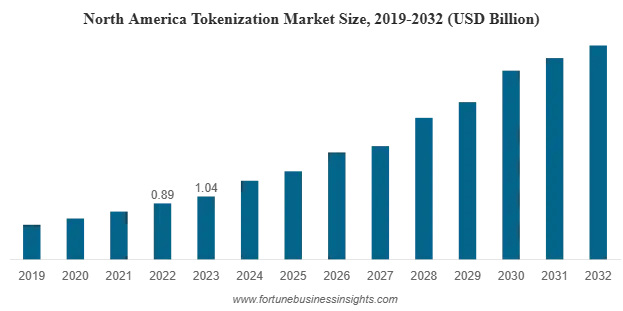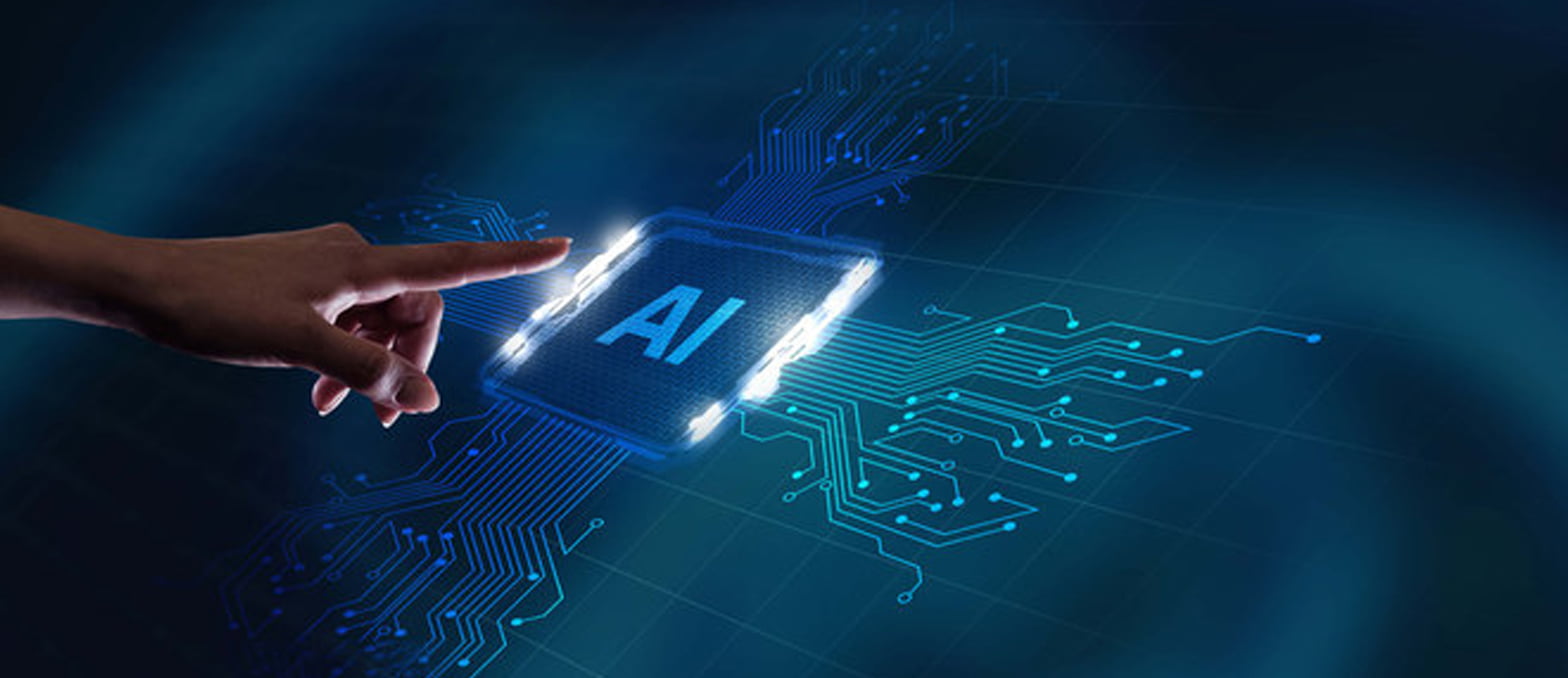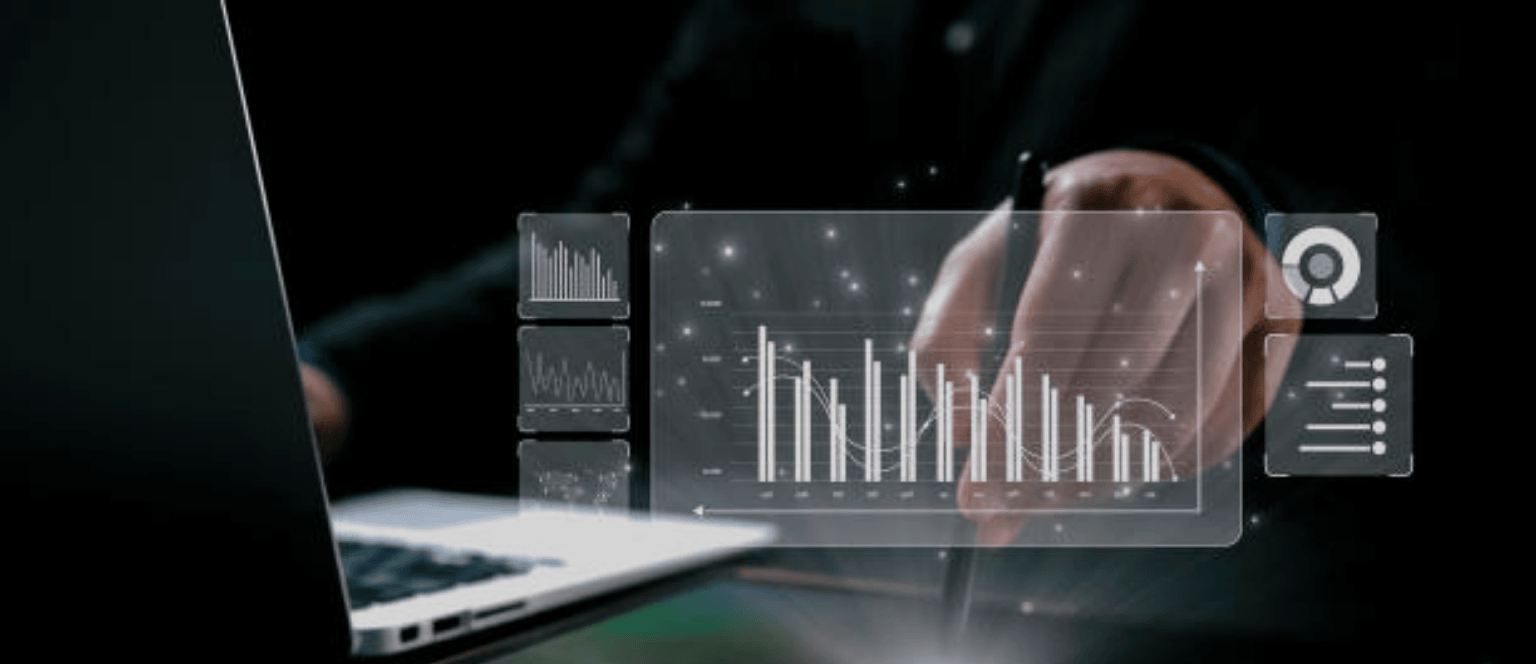Advancements in technology are reshaping established industries, with asset tokenization emerging as a significant idea. Asset Tokenization Platform Development, powered by blockchain technology, enables the creation of digital tokens from tangible and intangible assets. These tokens, which stand for ownership rights, let investors trade assets easily, take advantage of new investment possibilities, and participate in fractional ownership.
Asset tokenization is an extensive application of blockchain technology which enables the buying-selling and transferring of digital assets through the decentralized ledger. With tokenized assets businesses can efficiently and securely transfer ownership for assets; increase the liquidity of assets; and trade assets quickly and efficiently.
The concept is now one of the most prominent technologies in blockchain, and it allows new avenues for creating tokens for assets.
The global market for tokens is predicted to increase to $2.81 billion as of 2023 and $9.82 billion by 2030, with a rate of 19.6% over the projection period. The worldwide market for tokenization is increasing and will be slowing down soon, so introducing the idea into your company area will yield a profit concept.

In this blog, we will explore everything about asset tokenization platform development.
So, let’s get started.
Table of Contents
Asset Tokenization Platform Development:- Market Overview
Asset tokenization is the process of the ownership rights to things of value being converted into digital tokens, which are then stored on the blockchain. The tokens function as digital proof of ownership and could represent physical goods, digital assets, or even the right to something valuable, such as intellectual property.
This method increases the amount of trading, the efficiency of transactions, and security due to the development of fractional ownership and smart contracts. The tokenization process also removes middlemen, thereby reducing costs while increasing the value of the assets.
For example, if you own an art piece, you could safely store digital tokens of ownership on a blockchain rather than physical copies. This would allow you to prove that you own the work without having to have the actual piece.
The future of asset tokenization looks promising, with a projected 50x growth between 2022 and 2030, from $310 billion to $16.1 trillion. By the end of this decade, tokenized assets are expected to contribute 10% of the global GDP.
A study by BCG estimates that the value of tokenized assets could reach $ 16.1 trillion by 2030, presenting a significant opportunity for businesses. This growth signals a shift in capital towards practical blockchain applications.
Key Features of an Asset Tokenization Platform
One of the essential considerations for creating an asset tokenization platform is to include the right features that the issuers and investors could benefit from. Here are the key features to include in asset tokenization platform.
Streamlined Asset Onboarding and Tokenization
The onboarding of assets to the platform should be as seamless as possible. A system that would aim for simplicity in asset verification, asset categorization, and token structure generation for an improved, rapid, and worry-free experience for both issuers and investors.
Secure Management of Smart Contracts
Smart contracts are the base of all tokenization. A Smart Contract Development Company ensures the platform offers a secure space to launch, govern, and upgrade these contracts. Additionally, maintaining a history of versions and an audit trail for everything in the system ensures that every input and interaction is traceable back, enhancing transparency and security.
Asset Tracking and Investor Dashboard
A dashboard is what every investor should have access to, where they would see their tokens, asset performance and transaction history. It may also enable the management for dividends and voting that token holders are entitled to, if applicable.
KYC/AML Integrated Investor Management
The amalgamation of KYC and AML processes is important for regulatory compliance. It ensures secure account creation, profile management, and investor verification, preventing both the platform and users from scammers.
Compliance Tools for Regulatory Adherence
Something needs to be created in the platform to help keep you compliant with regulations. That could be systems to take care of accreditation rules and make sure of your investor suitability for token-based securities and local regulations so that all your transactions are above board and legal.
Advanced Security Protocols
Asset protection and user data safety are a must. The platform should have multi-factor authentication, secure data storage, and other protective measures in place to prevent breaches and exploitation of account exploitation. Consider the use of hardware wallets for added protection.
Issuer Management Tools
Even though the technology is different, issuers still need comprehensive token management tools for these products, too. These should monitor the secondary market of investors, compliance reports, and the entire token lifecycle of the token from when it is issued to when an issuer must pause or burn tokens.
Secondary Market Access
Allowing tokenized assets to be traded on a secondary market can increase liquidity. This feature could involve integrating with existing external exchanges or building an internal trading platform, with smooth processes for order placement, execution, and settlement.
Scalability and Performance Optimization
The platform needs to be scalable and should easily allow to operate when almost millions of users tend to use it at one point in time. Backing the underlying blockchain tech for the long haul is essential since that underpins the agility, rapidity, and security of the platform as it scales.
Leverage Secure Asset Tokenization Solutions Tailored to Your Needs
Development Process of an Asset Tokenization Platform
The process of creating an asset tokenization platform is meticulous and requires planning and execution through a variety of critical phases. This section will guide you through the procedure efficiently, so let’s have a look:
Defining Platform Goals
Make sure you clearly define what you would like the asset tokenization platform you choose to accomplish. Determine what kinds of assets you’ll deal with, including art, real estate, and intellectual property.
Consider the people using the platform: individuals, large institutions, or people from an industry. The knowledge gained will guide the specifications for the asset tokenization platform and ensure it can meet the intended users’ needs.
Choosing The Right Tech
The foundation of the asset asset tokenization platform development company is picking the best blockchain platform. We need a deep dive into how the scaling, consensus, transactions per seconds, and interoperability factors are taken into consideration by these approaches.
Choose best suitable Blockchain platform which has capacity to process huge transactions and has solid security features like cryptographic encryption algorithm and consensus algorithm. You should also check for smart contract language compatibility, regulatory compliance support, and standard tokens support.
Develop Smart Contracts
Smart contracts are the digital version of a contract on the blockchain. They are the building blocks of asset tokenization platforms that automate the issuance, transfer, and management of tokenized assets.
For this one reason, it is vital that coding be done in a safe manner and that strategies such as official verification and comprehensive checking are employed in order to discover and destroy vulnerabilities.
An asset tokenization platform development company ensures that smart contracts are flexible and well-documented, adhering to all relevant token standards to enhance interoperability and ease of future updates. In addition, they can create access control methods and role-based authorizations to limit unauthorized access to sensitive functions in the smart contract.
Design User-Friendly Interface And Experience
UI and UX layout is one of the most important factors concerning asset tokenization systems since it will impact the user satisfaction and experience as they go through accessing these assets at the end of the day. Develop a simple and mobile-friendly front end which streamlines the tokenization process, adding features such as asset discovery, transaction history, and portfolio management.
Use front-end frameworks and libraries to guarantee cross-browser compatibility and seamless interaction with users. Consider accessibility concerns and mobile responsiveness first to meet the needs of users using the platform across diverse devices and platforms.
Implementing Security Measures
Dealing with assets and cash of individuals requires superhigh security levels, which means the usage of security layers to protect users assets and personal information. Utilize the best encryption techniques to secure the data when in transit and at rest, which reduce the risk of unauthorized data access and security breaches.
Use vulnerability testing, code review, and intrusion detection systems to detect and fix security weaknesses. Furthermore, you can incorporate robust authentication methods like biometric or multi-factor authentication to improve the security of your user accounts and reduce the possibility of unauthorized access.
Testing And Launching
Before deploying the platform, thoroughly test all its components for asset tokenization, including smart contracts, APIs, and user interfaces. Use automated testing frameworks and techniques to test performance, functionality, and security under various circumstances.
Please set up a gradual deployment strategy, beginning with a few users, to get their feedback and spot potential issues before you launch the full version. Continuously monitor the platform after deployment, immediately addressing unexpected matters to provide a seamless user experience.
Maintenance
After your platform has been set up to operate, it is imperative to ensure that it continues to run for the longevity and success of your asset tokenization solution. Be aware of the newest technological advancements and regulations, and regularly update your platform to meet the ever-changing risks and compliance requirements.
Asset tokenization platform development company creates robust protocols for incident response and channels for support to resolve users’ questions and technical problems immediately.
Create a group of stakeholders and developers to help the platform evolve, making sure it is innovative and competitive within the constantly evolving world of tokenization technologies for assets.
Cost of Developing an Asset Tokenization Platform
Are you building an asset tokenization platform and wondering how much it will cost? Although costs vary massively, a standard blockchain platform may cost between $100,000 and $300,000 or more. So, what drives this cost?
The complexity of the platform is a massive part of the equation here, too. In general, while simple platforms with minimum tokenization functionalities are low in cost, advanced platforms with tailored features, enterprise-grade tokenization security, and heavy integrations can cost $5000 or more dollars a month.
Consider also the expertise of your development team. Skilled blockchain developers of asset tokenization platform development company and security experts don’t come cheap (especially with the demand growing). They are necessary if designing a secure and compliant platform.
Of course, regulatory compliance is a crucial aspect. Since asset tokenization involves navigating laws and regulations that fluctuate regionally, your platform must ensure Know Your Customer (KYC) and Anti-Money Laundering (AML) compliance. This compliance is often crucial to legal safety but adds to the overall cost of integrating these features.
Lastly, your budget should also include provisions for regular maintenance and updates. Constant investment will be needed to maintain your platform’s security and modular updates, as Blockchain technologies evolve rapidly. The upfront cost for developing a compliant asset tokenization platform can be substantial, but so can the ROI from a successful one in this fast-evolving financial landscape.
Key Benefits of Asset Tokenization Platforms
With its ability to facilitate never before seen benefits, asset tokenization platform development services can potentially revolutionize financial markets. This allows for cost-efficient systems for both asset holders and asset investors, but also provides additional means of accessing a new level of assets. Here are some of the key benefits offered by asset tokenization platforms:
Optimized Operations with Automation
The tokenization of an asset uses smart contracts to automate various processes involved in asset management, such as transferring ownership and continuously monitoring compliance. It automates processes that limit manual processes that lead to operational expense savings and human errors.
It likewise diminishes reliance on middle people, such as specialists and legal advisors, empowering quicker, more proficient activities that may bring down exchange costs and further develop the general productivity of the work cycle.
Improved Liquidity and Access to the Market
Tokenized assets are easier to trade in secondary markets than traditional assets, so they provide extra liquidity. This versatility opens new opportunities for both investors and asset owners. Investors have more buy sell opportunities while asset owners get faster liquidity. Tokenizing previously illiquid assets opens up new forms of trading and investing in access-challenged assets.
Higher Level of Security and Transparency
The transactions and ownership records of the assets are permanently recorded in the Blockchain technology and cannot be modified. Because an immutable ledger has a high transparency, it becomes less prone to tampering, thus minimizing fraud. This approach secures the data, records all ownership transfers, and boosts trust in the platform and the overall market for investors and asset owners.
Broadened investment opportunities
This also allows for innovative investment products that could make fractionalized ownership or bespoke investment vehicles possible through tokenization. This creates many new opportunities, which means investors can now gain a much more diverse set of assets, including asset classes that were totally inaccessible before (like real estate, fine art, etc.).
Furthermore, the platform enables alternative lending mechanisms, such as peer-to-peer lending, offering greater investment and wealth-generation opportunities.
Strategic Market Positioning
By launching a tokenization platform, you will become a pioneer in the fastest-growing asset management trend based on blockchain technology. Getting into this space early allows you to position yourself in front of investors eager to take advantage of what tokenized assets can provide.
An effective platform can bring new users, inspire innovation, and position your platform as the destination for market-leading digital asset management in your competitive landscape.
Challenges in Asset Tokenization Platform Development
Despite the endless possibilities of asset tokenization platform development services, it also comes with some challenges that need to be addressed. These problems should be well understood in order to create a successful platform. Here are some key obstacles:
Technical and Operational Complexity
Building and developing a solid, secure asset tokenization platform requires extensive technical knowledge. If the platform is not technically qualified or poorly optimized, it can lead to security vulnerabilities, bugs, and performance issues. Without such consistency, these operational complications can shake user confidence and obviously create a recipe for disaster, which involves spending a fortune.
Liquidity Issues
Building secondary markets for some non-mainstream assets could be difficult due to the process of tokenization. This will make it even more difficult for investors to buy and sell their tokens, thus negatively affecting the purpose and appeal of the platform. One of the main challenges to address is the acquisition of enough participants from the market and a liquid trading environment.
Unclear Regulatory Framework
The asset tokenization regulatory landscape is an ever-shifting mosaic, leading to a lack of clear guidelines. Potential concerns for both asset issuers and investors can delay adoption. Staying updated on legal developments and getting regulatory advice is critical in this complicated environment to achieve platform compliance and build trust in the platform.
Counterparty Risks
Because tokenization frequently involves dealing with various external parties — custodians, exchanges, smart contract developers, among others. If these parties fail or encounter issues, they can disrupt the entire platform, affecting both security and the transaction pipeline. Therefore, operators must carefully choose partners when scaling operations, ensuring they have the necessary contracts and safety controls in place.
Why Choose A3Logics for Asset Tokenization Platform Development?
Asset tokenization development is a revolutionary possibility for those looking to increase access, liquidity, asset management, and investment efficiency. By partnering with A3logics, a customized asset tokenization platform development company, companies can fully exploit the potential of this revolutionary technology.
Our extensive experience in asset tokenization development services and our comprehensive suite of solutions guarantee the smooth effective tokenization process. From asset identification through tokenization and beyond, we empower companies to understand the complexity of blockchain technology with confidence and comfort.
Blockchain experts at A3logics are passionate about delivering custom solutions to meet your particular business requirements for tokenizing the real estate market, financial assets, or digital collectibles. We’ll assist you in navigating the maze of tokenization beginning with selecting the best blockchain to designing a smooth user experience.
Our knowledge can simplify procedures for development and ensure that the platform is compliant to the ever-changing rules and regulations. Explore the possibilities of blockchain-based asset tokenization with A3logics, the best blockchain app development company and start a path to higher efficiency, security, and more significant innovation.
Transform Your Software Vision into Reality – Book A 30 Minutes Free Consultation!
Conclusion
The asset tokenization platform can be a revolutionary invention with the potential to transform our perception of and how we use traditional assets. The asset tokenization platform gives ownership rights represented by digital tokens using blockchain technology.
It offers many benefits and opportunities for businesses, investors, as well as the entire financial system. By tokenizing an asset, it becomes liquid and thus can be bought or sold seamlessly on digital marketplaces. This additional liquidity enhances the efficiency of markets, creates more investment options, and draws in buyers.
Asset tokenization’s future looks promising, with a steady expansion and widespread adoption anticipated in various sectors. With the general advancements in technology, and maturation of regulatory frameworks, we will see asset tokenization platform development company proliferate paving the way for more accessibility, liquidity, and efficiency in regards to both trading and asset management.
It opens the door to democratizing previously inaccessible investing opportunities and markets, along with accelerating operations around the globe. As blockchain development services advance, asset tokenization could change how assets are managed, owned, and managed over the years ahead.
FAQ’s
How does an Asset Tokenization Platform work?
What are the benefits of using blockchain for asset tokenization?
Some of the important advantages of asset tokenization on blockchain include transparency, security and immutability. Each tokenized asset is recorded on a blockchain which is an unchangeable record of ownership. This decrease fraud, increases trust, and helps in the tracking of ownership and transactions. Blockchain cuts out the middleman, lowering costs and accelerating transactions.
Which blockchain should I choose for asset tokenization?
Depending on scalability, security, and cost-efficiency, the right blockchain should be chosen. Common blockchains used for asset tokenization are Ethereum, because of its matured ecosystem and smart contract abilities, and Binance Smart Chain, which offers lower transaction fees. The same goes for potential new blockchains like Solana which are highly scalable, that is ideal for tokenization on a large scale.
How long does it take to develop an asset tokenization platform?
Asset tokenization platform development time is minimum 6 months to couple of years based of complexity and features offered by the platform. The time frame depends significantly on the type of blockchain you choose, the nature of platform regulation you have to comply with, whether you need to build a specific smart contract and other key factors, such as secure payment systems integration and user interface.
Of course, meticulous planning and an all-star development team can help get this done much more quickly.
Is an asset tokenization platform secure?
Asset tokenizing platforms, if developed with proper protocols, can be very secure. The inherent characteristics of blockchain such as immutability and decentralization foster security. However, the platform must also incorporate additional safety systems, such as multi-factor authentication, encryption, and routine audits.. Effectively developed smart contracts and testing for vulnerabilities can ensure the platform remains secure from external attacks.
What industries can benefit from asset tokenization?
Asset tokenization has the potential to assist many industries, such as real estate, art, finance and commodities. Tokenization with its fractional ownership will make real estate investment more accessible. Tokenization enables individuals to own high-value artworks fractionally within the art industry.
Moreover, tokenization has the potential to increase the liquidity and transparency of traditional markets such as commodities, equities, and bonds by making such assets more accessible to a broader public.
What is the role of smart contracts in asset tokenization?
By automating and safeguarding transactions, smart contracts are absolutely vital in asset tokenization. Self-executing agreements activate specific activities, such as transferring token ownership after payment, based on predefined criteria. They ensure transparency, reduce human errors, eliminate intermediaries, and streamline the tokenization process, making it faster and more cost-effective.







